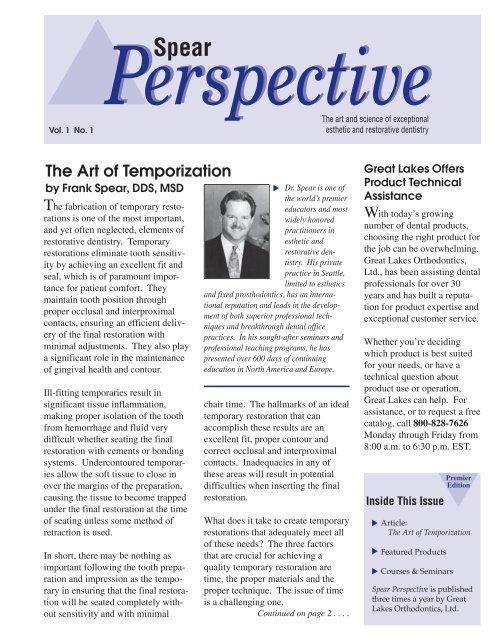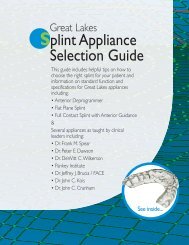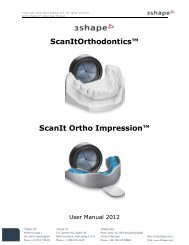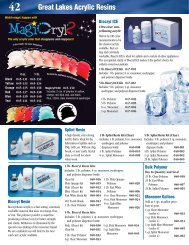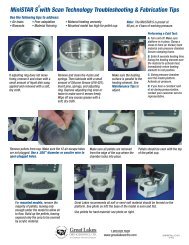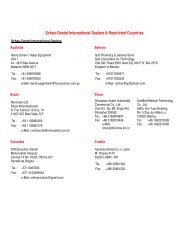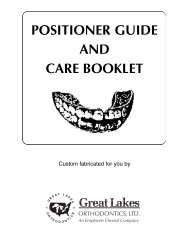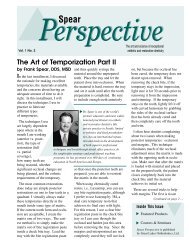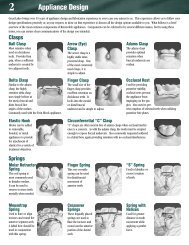T The Art of Temporization W - Great Lakes Orthodontics
T The Art of Temporization W - Great Lakes Orthodontics
T The Art of Temporization W - Great Lakes Orthodontics
You also want an ePaper? Increase the reach of your titles
YUMPU automatically turns print PDFs into web optimized ePapers that Google loves.
▲Spear<br />
T<br />
Vol. 1 No. 1<br />
Perspective<br />
<strong>The</strong> art and science <strong>of</strong> exceptional<br />
esthetic and restorative dentistry<br />
<strong>The</strong> <strong>Art</strong> <strong>of</strong> <strong>Temporization</strong><br />
by Frank Spear, DDS, MSD<br />
he fabrication <strong>of</strong> temporary restorations<br />
is one <strong>of</strong> the most important,<br />
and yet <strong>of</strong>ten neglected, elements <strong>of</strong><br />
restorative dentistry. Temporary<br />
restorations eliminate tooth sensitivity<br />
by achieving an excellent fit and<br />
seal, which is <strong>of</strong> paramount importance<br />
for patient comfort. <strong>The</strong>y<br />
maintain tooth position through<br />
proper occlusal and interproximal<br />
contacts, ensuring an efficient delivery<br />
<strong>of</strong> the final restoration with<br />
minimal adjustments. <strong>The</strong>y also play<br />
a significant role in the maintenance<br />
<strong>of</strong> gingival health and contour.<br />
Ill-fitting temporaries result in<br />
significant tissue inflammation,<br />
making proper isolation <strong>of</strong> the tooth<br />
from hemorrhage and fluid very<br />
difficult whether seating the final<br />
restoration with cements or bonding<br />
systems. Undercontoured temporaries<br />
allow the s<strong>of</strong>t tissue to close in<br />
over the margins <strong>of</strong> the preparation,<br />
causing the tissue to become trapped<br />
under the final restoration at the time<br />
<strong>of</strong> seating unless some method <strong>of</strong><br />
retraction is used.<br />
In short, there may be nothing as<br />
important following the tooth preparation<br />
and impression as the temporary<br />
in ensuring that the final restoration<br />
will be seated completely without<br />
sensitivity and with minimal<br />
▲<br />
Dr. Spear is one <strong>of</strong><br />
the world’s premier<br />
educators and most<br />
widely honored<br />
practitioners in<br />
esthetic and<br />
restorative dentistry.<br />
His private<br />
practice in Seattle,<br />
limited to esthetics<br />
and fixed prosthodontics, has an international<br />
reputation and leads in the development<br />
<strong>of</strong> both superior pr<strong>of</strong>essional techniques<br />
and breakthrough dental <strong>of</strong>fice<br />
practices. In his sought-after seminars and<br />
pr<strong>of</strong>essional teaching programs, he has<br />
presented over 600 days <strong>of</strong> continuing<br />
education in North America and Europe.<br />
chair time. <strong>The</strong> hallmarks <strong>of</strong> an ideal<br />
temporary restoration that can<br />
accomplish these results are an<br />
excellent fit, proper contour and<br />
correct occlusal and interproximal<br />
contacts. Inadequacies in any <strong>of</strong><br />
these areas will result in potential<br />
difficulties when inserting the final<br />
restoration.<br />
What does it take to create temporary<br />
restorations that adequately meet all<br />
<strong>of</strong> these needs? <strong>The</strong> three factors<br />
that are crucial for achieving a<br />
quality temporary restoration are<br />
time, the proper materials and the<br />
proper technique. <strong>The</strong> issue <strong>of</strong> time<br />
is a challenging one.<br />
Continued on page 2 . . . .<br />
<strong>Great</strong> <strong>Lakes</strong> Offers<br />
Product Technical<br />
Assistance<br />
W<br />
ith today’s growing<br />
number <strong>of</strong> dental products,<br />
choosing the right product for<br />
the job can be overwhelming.<br />
<strong>Great</strong> <strong>Lakes</strong> <strong>Orthodontics</strong>,<br />
Ltd., has been assisting dental<br />
pr<strong>of</strong>essionals for over 30<br />
years and has built a reputation<br />
for product expertise and<br />
exceptional customer service.<br />
Whether you’re deciding<br />
which product is best suited<br />
for your needs, or have a<br />
technical question about<br />
product use or operation,<br />
<strong>Great</strong> <strong>Lakes</strong> can help. For<br />
assistance, or to request a free<br />
catalog, call 800-828-7626<br />
Monday through Friday from<br />
8:00 a.m. to 6:30 p.m. EST.<br />
▼<br />
Inside This Issue<br />
▲ ▲ ▲<br />
<strong>Art</strong>icle:<br />
<strong>The</strong> <strong>Art</strong> <strong>of</strong> <strong>Temporization</strong><br />
Featured Products<br />
Courses & Seminars<br />
Premier<br />
Edition<br />
Spear Perspective is published<br />
three times a year by <strong>Great</strong><br />
<strong>Lakes</strong> <strong>Orthodontics</strong>, Ltd.
<strong>The</strong> <strong>Art</strong> <strong>of</strong> <strong>Temporization</strong><br />
Continued from front . . . .<br />
Many dentists find that having a well trained assistant fabricate the<br />
temporary following the final impression frees them up to move on to a<br />
different patient in another operatory. This also provides the assistant<br />
with the ability to fabricate the temporary without as much time pressure<br />
as there would be if another patient had to be moved into that chair<br />
immediately. However, many <strong>of</strong>fices do not have the operatories or the<br />
personnel to delegate temporary fabrication to. In these instances, the<br />
dentists must either allow themselves adequate time to properly fabricate<br />
the temporary or recognize that they will need to spend more time the<br />
day <strong>of</strong> seating because <strong>of</strong> the temporary’s deficiencies. It truly becomes<br />
a “pay me now” or “pay me later” experience with regard to chair time<br />
and temporaries. In addition, there are simply some patients whose<br />
temporaries will require the dentist’s input during fabrication. <strong>The</strong>se may<br />
include patients with significant occlusal problems, difficult esthetic<br />
management or complex reconstruction involving a significant number <strong>of</strong><br />
teeth. In these complex patients, charging a separate provisional fee <strong>of</strong><br />
approximately 30% <strong>of</strong> the per unit crown fee is encouraged so that the<br />
dentist feels adequately compensated to take the necessary time to fabricate<br />
an excellent set <strong>of</strong> temporaries.<br />
Today there are many choices <strong>of</strong> materials available for the fabrication <strong>of</strong><br />
temporary restorations. Historically, methyl methacrylates such as<br />
Temporary Bridge Resin by Caulk and Jet by Lang have been used for<br />
years. <strong>The</strong> physical properties <strong>of</strong> these materials are typically quite<br />
acceptable with regard to strength and wear resistance.<br />
However, their long-term color stability is poor and their fabrication<br />
techniques are somewhat frustrating due to shrinkage, one <strong>of</strong> the methyl<br />
methacrylates’ biggest drawbacks. It necessitates that significant care<br />
must be used to avoid locking the material in the mouth during fabrication<br />
and to ensure good marginal fidelity. In addition to shrinkage, these<br />
materials generate significant heat during their setting reaction. <strong>Great</strong><br />
care must be taken to avoid overheating the tooth during setting if they<br />
are used directly in the mouth. One <strong>of</strong> the advantages <strong>of</strong> using methyl<br />
methacrylates, however, is the ease <strong>of</strong> adding to them during fabrication,<br />
which helps to alleviate the problem <strong>of</strong> marginal fidelity due to shrinkage.<br />
Methyl methacrylates are<br />
certainly appropriate materials to<br />
use today in fabricating temporaries<br />
if you have mastered the techniques<br />
necessary to work with them.<br />
However, there are many newer<br />
materials available that are much<br />
easier to use.<br />
Ethyl methacrylates, such as Snap<br />
and Trim, are another class <strong>of</strong><br />
materials that have been available<br />
for a long period <strong>of</strong> time. <strong>The</strong>se<br />
“<strong>The</strong> three factors<br />
that are crucial for<br />
achieving a quality<br />
temporary restoration<br />
are time, the proper<br />
materials, and the<br />
proper technique.”<br />
materials countered some <strong>of</strong> the<br />
problems the methyl methacrylates<br />
had, such as shrinkage and<br />
heat upon setting, but added some<br />
additional problems <strong>of</strong> their own.<br />
<strong>The</strong>y have very poor color stability<br />
and wear resistance and are<br />
difficult to add to. Nevertheless,<br />
many dentists used them because<br />
<strong>of</strong> their lack <strong>of</strong> shrinkage compared<br />
to the methyl methacrylates.<br />
<strong>The</strong> next significant class <strong>of</strong><br />
materials is the chemical cure<br />
composite resins, including products<br />
such as ProTemp, Luxatemp<br />
and Integrity. <strong>The</strong>se products<br />
overcome many <strong>of</strong> the shortcomings<br />
<strong>of</strong> the acrylics. <strong>The</strong>y have<br />
very little shrinkage, minimal heat<br />
upon setting and good color<br />
stability and wear resistance. In<br />
addition, many are dispensed in<br />
cartridges, making mixing very<br />
easy, and they do not have the<br />
odor associated with acrylics.<br />
<strong>The</strong>y are also very easy to add to<br />
by following the same steps used<br />
for any composite addition. Of<br />
their few disadvantages, their<br />
ability to lock into undercuts or<br />
onto teeth may be the most significant.<br />
This is easily remedied by<br />
paying attention to the setting<br />
time. Otherwise, the only complaints<br />
from practitioners seem to<br />
be a somewhat brittle nature and<br />
occasional bubbles from the<br />
mixing systems. Suffice it to say<br />
they are one <strong>of</strong> the most popular<br />
temporary materials on the market<br />
today.<br />
Composite resin technology is<br />
responsible for the last two classes<br />
<strong>of</strong> materials as well: light cure<br />
only and dual cure products.<br />
Light cure only products, including<br />
Triad or flowable composites,<br />
give the operator the advantage <strong>of</strong><br />
being in total control <strong>of</strong> the curing.<br />
This eliminates the need to time
the set. However, they can still<br />
lock on since they become very<br />
hard when cured. <strong>The</strong>refore,<br />
rather than timing the setting, the<br />
operator must learn how much<br />
light application is necessary to<br />
harden the material without<br />
locking it on. It can then be<br />
removed and the curing completed<br />
<strong>of</strong>f the tooth. If it is undercured,<br />
however, some <strong>of</strong> the material<br />
may be left on the tooth when it is<br />
removed for final curing, resulting<br />
in an open margin. In spite <strong>of</strong><br />
these shortcomings, when used<br />
properly these products can make<br />
excellent temporary restorations<br />
with excellent physical properties<br />
and esthetics. Ivory light-colored<br />
Triad is one <strong>of</strong> my favorite materials<br />
for anterior temporaries.<br />
<strong>The</strong> final class <strong>of</strong> materials is the<br />
dual cure products, such as<br />
Isotemp and Unifast. Isotemp is a<br />
composite resin based product<br />
similar to Luxatemp, except that<br />
its polymerization is not completed<br />
until a light is applied.<br />
Unifast is an acrylic based material<br />
with similar characteristics,<br />
i.e., partial setting from a chemical<br />
reaction but dependant upon light<br />
for complete setting. Following<br />
final curing, each <strong>of</strong> these materials<br />
then behave with the same<br />
physical properties <strong>of</strong> other materials<br />
in their class, so that Isotemp<br />
will act like a composite and<br />
Unifast will act like an acrylic.<br />
<strong>The</strong> major rationale for using both<br />
<strong>of</strong> these products is that neither<br />
will set completely until the light<br />
is applied, which minimizes the<br />
risk <strong>of</strong> locking the restoration in<br />
place. Yet, because there is an<br />
initial chemical cure occurring, it<br />
is possible to remove them with<br />
minimal distortion. <strong>The</strong>y can then<br />
be either cured out <strong>of</strong> the mouth or<br />
placed back on the teeth after<br />
removing any excess material<br />
from undercuts and final cured. This can be a tremendous advantage<br />
over chemical cure only products.<br />
In my practice, I use Temporary Bridge Resin by Caulk, a methyl methacrylate,<br />
for complex full arch reconstructions; and Triad by Dentsply, a<br />
light cured product, for many <strong>of</strong> the anterior restorations. I have found<br />
Isotemp by 3M, a dual cure resin, to be a good material for everything<br />
else.<br />
In the next installment, I’ll describe the fabrication techniques I use with<br />
these materials directly in the mouth, indirectly on a model and a combination<br />
<strong>of</strong> the two, where the temporary is fabricated indirectly on a<br />
model, but lined directly in the mouth.<br />
▲<br />
Featured Products<br />
Duoloid Hydrocolloid System<br />
Duoloid is a syringable hydrocolloid<br />
occlusal impression material that, when<br />
used in conjunction with Prep Wet and<br />
Duoloid Alginate, assures an impression<br />
with excellent definition and no nodules<br />
on the model when poured.<br />
This ensures that the restoration<br />
or appliance fits properly<br />
on the occlusal surfaces. <strong>The</strong><br />
DryProcessor II heats the<br />
Duoloid Hydrocolloid so it<br />
can be syringed onto the<br />
occlusal surfaces <strong>of</strong> the teeth.<br />
Triad II VLC Light Curing System<br />
Place, shape and cure Triad Materials accurately<br />
during fabrication, dramatically reducing finishing<br />
time. Triad materials are ready to use right from<br />
the package. <strong>The</strong>re’s no mixing, no mess and no<br />
<strong>of</strong>fensive monomer odor.<br />
Master Trays<br />
Disposable impression tray that works like<br />
a custom tray. Simply heat-treat with a<br />
flame at chairside and mold to patient’s<br />
individual anatomy.


